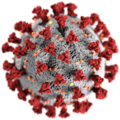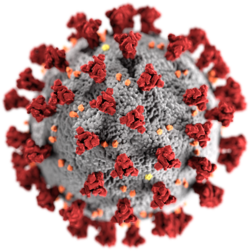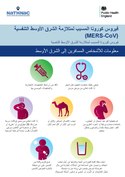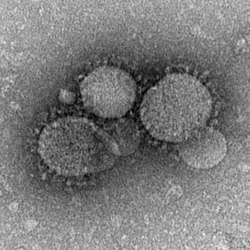MERS-CoV
 Denne artikel bør gennemlæses af en person med fagkendskab for at sikre den faglige korrekthed.
Denne artikel bør gennemlæses af en person med fagkendskab for at sikre den faglige korrekthed.
.. infoboksen bør efterses og evt. suppleres- Denne side handler om virussen "Middle East respiratory syndrome related coronavirus" . For sygdommen "Middle East Respiratory Syndrome", se MERS .
| MERS-CoV | |
|---|---|
![MERS-CoV-partikler set med elektronmikroskop. Viruspartiklerne har karakteristiske kronelignende pigge på membrankappen[1] Tilhører virusgruppe IV](http://upload.wikimedia.org/wikipedia/commons/thumb/8/87/MERS-CoV_electron_micrograph1.jpg/220px-MERS-CoV_electron_micrograph1.jpg) MERS-CoV-partikler set med elektronmikroskop. Viruspartiklerne har karakteristiske kronelignende pigge på membrankappen[1] Tilhører virusgruppe IV | |
| Videnskabelig klassifikation | |
| Domæne | Riboviria |
| Rige | Orthornavirae |
| Række | Pisuviricota |
| Klasse | Pisoniviricetes |
| Orden | Nidovirales |
| Familie | Coronaviridae |
| Slægt | Betacoronavirus |
| Art | Middle East respiratory syndrome related coronavirus |
| Kort | |
 100+ bekræftede tilfælde 50+ bekræftede tilfælde 1+ bekræftede tilfælde (Maj 2014) | |
| Hjælp til læsning af taksobokse | |
MERS-CoV (Middle East respiratory syndrome-related coronavirus) er en virus i coronavirus-familien, der blev identificeret første gang i 2012, og som kan forårsage alvorlig luftvejsinfektion, lungebetændelse og nyresvigt hos mennesker. Indtil videre har alle infektioner oprindelse på den arabiske halvø især omkring Saudi-Arabien. De sygdomstilfælde, som sundhedsmyndighederne har fået kendskab til, var for det meste alvorlige og ofte dødelige; det vides imidlertid ikke, hvor mange af de inficerede mennesker der udvikler sygdom.[2] Baseret på det hidtidige epidemiologiske mønster for spredningen kan det antages, at MERS-CoV kun vanskeligt overføres fra person til person[3], og at de primære værtsorganismer sandsynligvis er flagermus[4][5], hvorfra det − via dromedarer som mellemvært[6][7][8] − sporadisk er overført til mennesker.
Indtil videre er der ingen bevist og sikker antiviral terapi for dem der på grund af MERS-CoV udvikler MERS, Middle East Respiratory Syndrome. Behandling af syge er derfor begrænset til at lindre symptomerne.[9] Rejseadvarsler eller handelsbegrænsninger er (pr. januar 2016) ikke eksplicit godkendt af WHO.[10][11]
Galleri
|
|
Referencer
- ^ "Human Coronavirus, Middle East Respiratory Syndrome (MERS) og Svær Akut Respiratorisk Syndrom (SARS)" fra Ssi.dk, Statens Seruminstitut ("... Humane coronavirus (CoV) er navngivet efter de krone-lignende pigge der findes på virus' overflade ...")
- ^ WHO Press Statement Related to the Novel Coronavirus Situation. Fra: who.int 12. maj 2013.
- ^ WHO concludes a MERS-CoV risk assessment mission in the United Arab Emirates. Erklæring fra WHO 6. juni 2014. "... The preliminary result of the mission indicates that the cases in UAE do not show evidence of sustained human to human infection. The recent upsurge of cases in Abu Dhabi appears to have been caused by a combination of factors, including a breach in infection prevention and control measures in health care settings, active surveillance and increase in community acquired cases. ..."
- ^ Ziad A. Memish et al.: "Middle East Respiratory Syndrome Coronavirus in Bats, Saudi Arabia." I: Emerging Infectious Diseases. Bind 19, nr. 11, 2013, doi:10.3201/eid1911.131172
- ^ Ndapewa Laudika Ithete et al.: "Close Relative of Human Middle East Respiratory Syndrome Coronavirus in Bat, South Africa." I: Emerging Infectious Diseases. Bind 19, nr. 10, 2013, doi:10.3201/eid1910.130946 −
* "Stammt das 'MERS-Coronavirus' aus Afrika?" af Johannes Seiler fra Rheinische Friedrich-Wilhelms-Universität, Bonn (Pressemeddelelse 24. juli 2013 hos Informationsdienst Wissenschaft, idw-online.de). Hentet 15. september 2015}} - ^ Jamal S. M. Sabir et al.: "Co-circulation of three camel coronavirus species and recombination of MERS-CoVs in Saudi Arabia." I: Science. Bind 351, nr. 6268, 2016, s. 81-84, doi:10.1126/science.aac8608
- ^ Chantal BEM Reusken et al.: "Middle East respiratory syndrome coronavirus neutralising serum antibodies in dromedary camels: a comparative serological study." I: The Lancet Infectious Diseases. Bind 13, nr. 10, 2013, s. 859-866, doi:10.1016/S1473-3099(13)70164-6 −
* "Dromedare als Übertragungsquelle für gefährliche Virusinfektion unter Verdacht" af Klaus Herkenrath fra Rheinische Friedrich-Wilhelms-Universität, Bonn. (Pressemeddelelse 9. august 2013 hos Informationsdienst Wissenschaft, idw-online.de). Hentet 15. september 2015 –
Sml. dog også: Kai Kupferschmidt: Researchers Scramble to Understand Camel Connection to MERS. I: Science. Bind 341, nr. 6147, 2013, s. 702, doi:10.1126/science.341.6147.702 - ^ Kai Kupferschmidt: "The Camel Connection." I: Science. Bind 343, nr. 6178, 2014, side 1422-1425, doi:10.1126/science.343.6178.1422
- ^ Could antibodies from camels protect humans from MERS? Arkiveret 16. juni 2020 hos Wayback Machine. Fra: eurekalert.org, 30. marts 2015
- ^ Middle East respiratory syndrome coronavirus (MERS-CoV) – Oman.. Fra: who.int, 7. januar 2016 ("... WHO remains vigilant and is monitoring the situation. Given the lack of evidence of sustained human-to-human transmission in the community, WHO does not recommend travel or trade restrictions with regard to this event. Raising awareness about MERS-CoV among travellers to and from affected countries is good public health practice.")
- ^ WHO: Middle East respiratory syndrome coronavirus (MERS-CoV). Fact sheet No. 401 fra: who.int, juni 2015. – ("... Travel : WHO does not recommend the application of any travel or trade restrictions or entry screening related to MERS-CoV. ..." (as of 11 March 2019)
- ^ "MERS-Coronavirus" fra Sundhed.dk
Se også
- MERS, Middle East Respiratory Syndrome, sygdommen som forårsages af virussen MERS-CoV
- Kapsid − Bakteriofag
Eksterne henvisninger
 Wikispecies har taksonomi med forbindelse til Middle East respiratory syndrome-related coronavirus
Wikispecies har taksonomi med forbindelse til Middle East respiratory syndrome-related coronavirus Wikimedia Commons har flere filer relaterede til Middle East respiratory syndrome coronavirus (virussen) og Middle East respiratory syndrome (sygdommen)
Wikimedia Commons har flere filer relaterede til Middle East respiratory syndrome coronavirus (virussen) og Middle East respiratory syndrome (sygdommen)- "Human Coronavirus, Middle East Respiratory Syndrome (MERS) og Svær Akut Respiratorisk Syndrom (SARS)" fra Ssi.dk, Statens Seruminstitut
- "MERS-Coronavirus" (virussen) og "MERS" (sygdommen) fra Sundhed.dk
- Robert Koch-Institut: Information om MERS-CoV, hentet 9. juni 2015. (tysk)
- WHO: Information om Coronavirus og MERS-CoV, 9. juni 2015 (engelsk)
- WHO: Riskassessment (risikovurdering), 24. april 2014 (PDF, (engelsk) hentet 9. juni 2015
- "Middle East respiratory syndrome coronavirus: epidemiology and disease control measures." − Systematisk oversigtsartikel af Jaffar A. Al-Tawfiq og Ziad A. Memish. I: Infection and Drug Resistance. Bind 7, 2014, s. 281-287, doi:10.2147/IDR.S51283 (fri som PDF).
- WHO: Rejseanbefalinger til Den Arabiske halvø fra 5. juni 2013 (engelsk) hentet 9. juni 2015
Medier brugt på denne side
Forfatter/Opretter: Mikael Häggström, Licens: CC0
Symptoms of Middle East respiratory syndrome, taken from entries at corresponding Wikipedia article.
This illustration, created at the Centers for Disease Control and Prevention (CDC), reveals ultrastructural morphology exhibited by coronaviruses. Note the spikes that adorn the outer surface of the virus, which impart the look of a corona surrounding the virion, when viewed electron microscopically. A novel coronavirus, named Severe Acute Respiratory Syndrome coronavirus 2 (SARS-CoV-2), was identified as the cause of an outbreak of respiratory illness first detected in Wuhan, China in 2019. The illness caused by this virus has been named coronavirus disease 2019 (COVID-19).
Forfatter/Opretter: Public Health England, Licens: OGL 3
Infographics with advice for people travelling to the Middle East from the UK (Arabic version)
Forfatter/Opretter: Sciencia58, Ernest Protheroe, Jukka A. Lång, Bjørn Christian Tørrissen, Linda Salzman Sagan (original artwork); Tompw (GIF version); User:Holek (SVG), NPS Graphics, converted by User:ZyMOS, Literaturquelle: [1], Licens: CC BY-SA 4.0
Übertragung von MERS-CoV und SARS-CoV-1 auf den Menschen über Säugetiere als Vektoren
MERS-CoV particles as seen by negative stain electron microscopy. Virions contain characteristic club-like projections emanating from the viral membrane.
Forfatter/Opretter: Renzoy16, Licens: CC BY-SA 3.0
MERS-CoV cases:
Forfatter/Opretter: Phoenix7777, Licens: CC BY-SA 4.0
MERS outbreak in the world - WHO

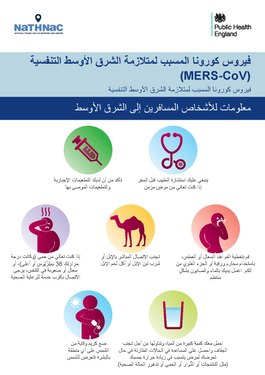
![Symptomer på sygdommen MERS[12]](http://upload.wikimedia.org/wikipedia/commons/thumb/f/ff/Symptoms_of_MERS_%28raster%29.png/500px-Symptoms_of_MERS_%28raster%29.png)

